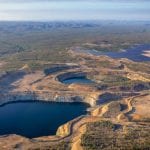Around The Web
Genex to add more solar and wind to pumped hydro after Queensland funds new link
 Queensland government to tip $132m into new transmission line linking pumped hydro facility with main grid in move that will open up more wind and solar capacity.
Queensland government to tip $132m into new transmission line linking pumped hydro facility with main grid in move that will open up more wind and solar capacity.
The post Genex to add more solar and wind to pumped hydro after Queensland funds new link appeared first on RenewEconomy.
Meat-eating plants making a comeback in England
Victoria rooftop solar scheme to re-open Thursday – 6,000 rebates still on offer
 Solar Victoria's online application portal to re-open Thursday September 5 at 9am, with around 6,000 home solar rebates still up for grabs.
Solar Victoria's online application portal to re-open Thursday September 5 at 9am, with around 6,000 home solar rebates still up for grabs.
The post Victoria rooftop solar scheme to re-open Thursday – 6,000 rebates still on offer appeared first on RenewEconomy.
CP Daily: Tuesday September 3, 2019
UK emitters to receive 10-month carbon price ‘holiday’ upon no-deal Brexit
Australia 'on track' to meet Renewable Energy Target
California Tropical Forest Standard leaves stakeholders divided despite revisions
Climate crisis: Greenland's ice faces melting 'death sentence'
Tasmania wind farm delivers Australia renewables target, with more in pipeline
 The Clean Energy Regulator has declared Australia’s 2020 renewable energy target to be officially met, after the Cattle Hill wind project in Tasmania took the total amount of committed wind, solar and other renewable projects to more than 6,400MW. That’s the capacity that the CER estimates is required to meet the 2020 target of 33,000GWh...
The Clean Energy Regulator has declared Australia’s 2020 renewable energy target to be officially met, after the Cattle Hill wind project in Tasmania took the total amount of committed wind, solar and other renewable projects to more than 6,400MW. That’s the capacity that the CER estimates is required to meet the 2020 target of 33,000GWh...
The post Tasmania wind farm delivers Australia renewables target, with more in pipeline appeared first on RenewEconomy.
Climate explained: why your backyard lawn doesn't help reduce carbon dioxide in the atmosphere
Nice try Mr Taylor, but Australia's gas exports don't help solve climate change
Anti-fracking trio given suspended sentences for breaking protest ban
‘The fight goes on,’ say activists after ignoring injunction at Cuadrilla site in Lancashire
Three anti-fracking activists have been given suspended prison sentences after breaking a ban on demonstrations which their lawyers argued “severely curtails the right to protest”.
The trio were convicted after ignoring an injunction brought by the energy company Cuadrilla to protect its Preston New Road site near Blackpool, Lancashire.
Continue reading...Should one use a private jet to campaign over climate crisis?
Prince Harry has faced flak for his carbon footprint but others face similar dilemma
Their style could hardly be more different, though their aims are the same: as Greta Thunberg sailed into New York last week on a low-carbon high-tech yacht to highlight the climate crisis, Prince Harry faced flak for taking private jets for short-hop breaks while campaigning against global heating. But the contrast between the two reflects broader dilemmas in the environmental movement.
On Tuesday, the Duke of Sussex invited further ridicule as he flew into Amsterdam – a direct Eurostar train from London takes three hours and 41 minutes – to unveil a new initiative for the tourism industry, Travalyst, aiming to reduce the impact of holidaymakers – while encouraging travel.
Continue reading...


